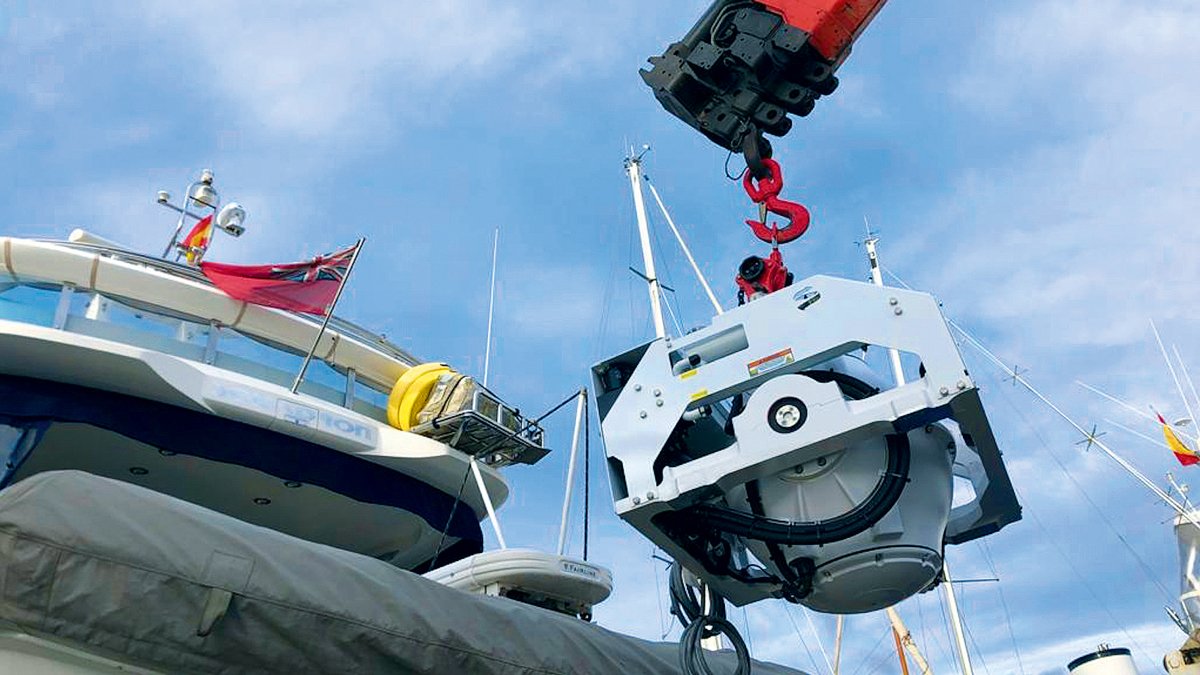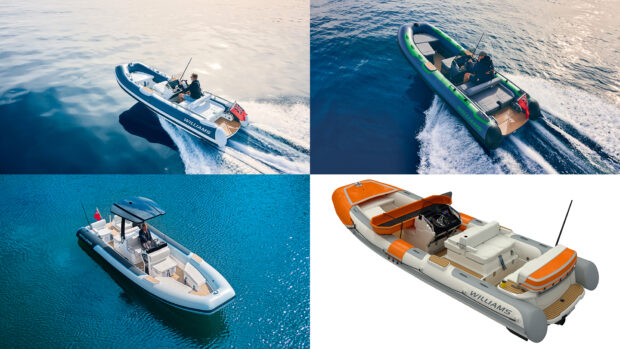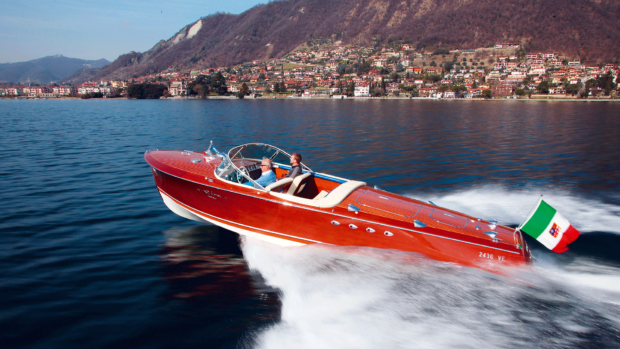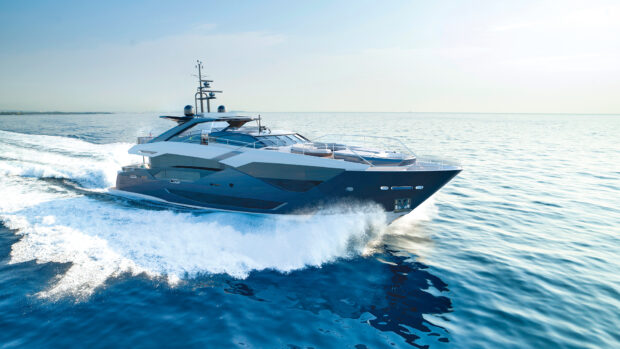Fed up with passing wakes and swelly anchorages sending his lunch crashing to the floor, Fairline Squadron 58 owner Jeremy Rudge decides to fit a Seakeeper SK6 stabiliser. But at what cost?
Like most boat owners, I had long wanted to fit some form of stabilisation to our 2004 Fairline Squadron 58.
In the four years I have owned her, we have made extensive improvements: new interior, electric blinds, new exterior upholstery, new teak, new helm seats, helm refurbishments, mood lighting, watermaker and much more.
There were not many projects left and I had no real desire to change the boat, so adding stabilisers was the obvious next step. The snag? Simple: cost.
There is no cheap way to stabilise a boat. I’d assumed electric fins would be cheaper than hydraulic ones – just how much can a few motors attached to some flippers cost?
Article continues below…

Smartgyro SG40 vs Seakeeper SK9: Boat stabilisers compared

Seakeeper targets high-end motor yachts with Seakeeper 18 gyroscopic stabiliser
Answer: even more than hydraulic fins! How much are hydraulic fins? Even more than a gyro. Oh well, a gyro it is then! But fitting a gyro stabiliser brought with it two problems.
Money, as I have already alluded to, but also where on earth to put it without spoiling the boat and losing space we actually used.
A chat with Seakeeper distributors Osmotech in Southampton yielded a price that, while as much as a Porsche Cayenne for a steel beach ball with some electronics attached, I could live with. So that just left the question of where to put it.
Seakeeper SK6 installation
We looked at multiple options. Crew cabin? No. We use the crew cabin for, er, crew! Utility room? Possible, but the Fairline Squadron 58 galley has very limited storage so the practicality of the whole boat revolves around the utility room, which in my case holds a washing machine, second fridge and lots of cupboard space.
There was also the small matter of getting it into the utility room, which while it didn’t faze Osmotech (we’ll just cut out the roof!) did not fill me with joy, and the idea of a smaller utility room went down even worse with my partner Joanna.
The only other fitting option was to remove the batteries from the lazarette, drop the gyro in their place and relocate the batteries. It would make the lazarette about 8in shallower but that wasn’t a problem as it was pretty deep anyway.
The next issue was where to put the batteries. Osmotech assured me they would find a suitable place once the boat was in bits but the hope was that they could go below the floor of the crew cabin.
Despite this uncertainty, I gave them the go-ahead and the boat was duly taken to pieces.
Unfortunately, finding a home for six very large batteries proved to be more of a challenge than expected. The crew cabin floor did not have enough depth and putting them in there would have meant losing one bunk and restricting access to the stern locker.
It would have also put a load more weight at the stern of the boat, which given that we were about to drop in an extra 400kg of Seakeeper as well, did not seem like a great idea.
We considered putting them under the port cabin beds but the cable runs would have been too long. That just left the engineroom.
On a Fairline Squadron 58 there is a void covered by a panel next to the generator. This looked hopeful. The suggestion was to split the batteries between there and another similar void on the other side.
The only snag was that getting those batteries out again would be a major job as the gyro would effectively block them in. At this point I think Osmotech were losing the will to live.
The Squadron 58 is generously proportioned but the engineroom is not really fit for a cocktail party and we were running out of options.
Their solution was to build a custom racking system that would allow the batteries to be stacked two deep next to the generator. This would then be boxed in and vented to keep them safe and secure from the rest of the engineroom.
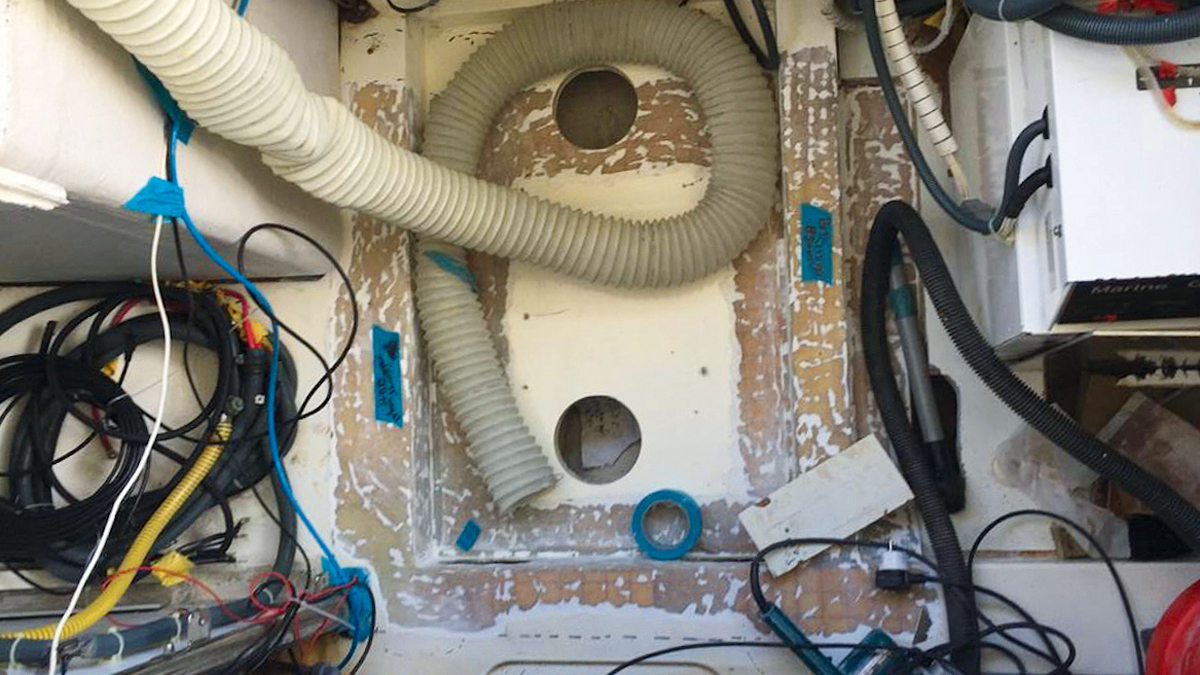
Once the batteries were removed from the lazarette, the Seakeeper mount was secured to the hull and the SK6 lowered into place
This was a great idea. The batteries wouldn’t impact engineroom access and would still be reasonably easy to change. That said, to avoid having to change them for as long as possible I asked for the batteries to be given a health check.
Even though they weren’t yet causing any issues they all failed the test – so it was out with the credit card once again so a new set could be fitted.
After four long weeks and plenty of head scratching and tooth sucking, the gyro was finally in and the only thing left was to find out if it worked. Seakeeper has an app that measures boat roll with the gyro on and off.
The official sea trial showed an 84% reduction in roll and my own test in an otherwise untenable anchorage showed a similar 83% reduction.
Gyro life
Having never been out on a stabilised boat before I didn’t really know what to expect. Firstly, you can hear it spinning, which was a slight surprise. I would liken the noise to the engine fans being on.
That said, you need to run the generator all the time anyway and that drowns out pretty much all of the gyro noise. So the only time you’re really aware of it is when you return to port at the end of the day and switch off the engines and generators, at which point it takes about half an hour for the noise to subside, even though it takes a further three to four hours for it to stop spinning!
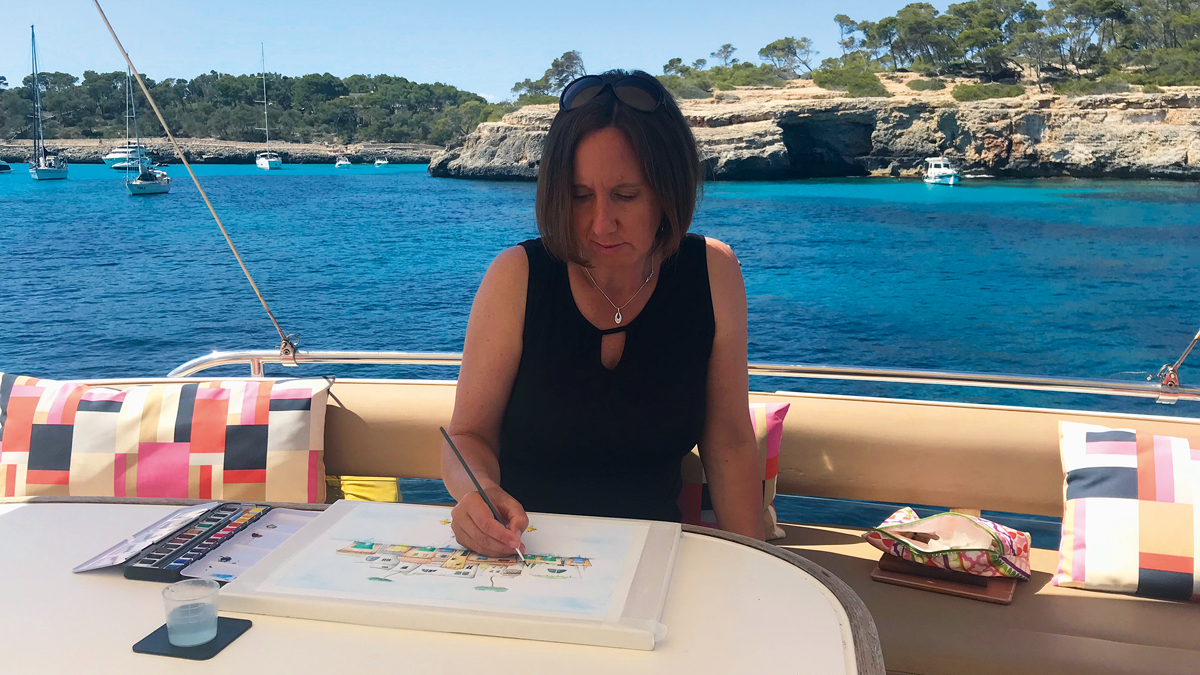
Artist Joanna can now paint on board without fear of passing wakes. See her work at: joannabenfieldart.com
The first time I took it out, there was a Force 4 blowing directly into Bossy’s home port of Cala d’Or, Mallorca. The waves were about 1.5m high and I put the boat beam on to see what happened.
To my disappointment it rolled. I went to the cockpit to better judge the size of the swell and was met with a wall of water approaching me – it really was pretty rough.
I then turned the gyro off and all hell broke loose. Lesson one: you can’t defy the laws of physics! The gyro reduced the roll and just as importantly, rather than the boat taking some time to settle after each wave had passed, it just stopped bolt upright after the initial roll.

Results of the sea trial showed an 84% reduction in roll with the Seakeeper SK6 running, enough to make otherwise untenable anchorages comfortable for Jeremy and his guests
A more real world test took place a few days later in an exposed anchorage with a swell of about one metre. The gyro removed all but the worst of it, with the control panel showing roll of between 0 and 1 degree most of the time.
Every now and then a larger wave would make the boat roll a few more degrees but it turned a marginal anchorage into a good one.
Just don’t expect it to turn a rough anchorage into a mill pond – it can reduce roll but not eliminate it altogether. A larger gyro might give even better results but a larger gyro was not practical or possible on Bossy.

Once in situ the Seakeeper is relatively discreet and any noise it makes is masked by the sound of the generator, which needs to run continuously to keep the gyro powered up
A long wavelength swell is more of an issue as the gyro can only suppress the roll for as long as the flywheel is being swung backwards or forwards on its axle by a hydraulic ram (known as precession).
There is a balance to be struck between how fast the flywheel is being moved (the force) and the time that force can be applied for. The electronics sort this out but if a roll needs three seconds of force to suppress it and only two seconds are available then the boat will roll. I am sure there is a more technical explanation but I think this captures it.
Boat wakes, on the other hand, simply disappear and an already calm anchorage becomes as still and peaceful as a marina, as we discovered during an overnight trip to Es Trenc – a huge beach with clear blue seas and a sandy bottom.
My partner is an artist and she now sits on the boat all day painting – an impossible dream in pre-stabiliser days – so overall it is pretty stable!
User friendly
Seakeeper has taken simplicity to an extreme. There is an on/off button and a stabilise/don’t stabilise button. That is it. There is also a quiet mode that reduces the gyro speed by about 1,000rpm but I can’t really see why you would want to use it given that you can’t hear it over the generator.
It is a shame there isn’t an app connected by Bluetooth as that would let you see what the gyro was up to from the upper helm without having to install a second set of controls.
It would also allow you to turn the stabilisation off. I am sure this desire is suppressed with time but as a new owner you always want to know what it’s like without the gyro on just to remind you why you spent all that money!
It also lacks a couple of other features that strike me as obvious – the ability to automatically switch stabilisation on when it reaches operational speed and a remote start so you can programme it to begin spooling up 40 minutes before you want to leave your berth.
The only other surprise is the frustratingly basic documentation supplied with such a sophisticated and expensive bit of kit.
The only way I have found of getting more information is by going to the FAQs section of the Seakeeper website, which covers things that really ought to be in the operating manual, such as warnings about avoiding sudden manoeuvres with the gyro on, for example. Even then the FAQ pages do not cover some real world limitations.
Seakeeper cost options
The cost will vary depending on how complex the installation is. Some newer boats already have the cradle for a gyro pre-installed during the build, making it almost a drop-in option.
As a rule of thumb for retrofitting one to an older boat, take the cost of the gyro excluding VAT and double it to give you a rough idea of the likely total cost.
Seakeeper also sells factory refurbished units for a discount of around 20 per cent, which helps make the numbers more palatable. Mine was a refurbished unit, the only difference being a one year warranty as opposed to two, but you can still extend the warranty if you wish.
Another cost you will need to factor in is running your generator all the time you are on the boat. You may do this anyway for powering the air con etc but it does rack up – in my case £100 or so of diesel every 24 hours.
Finding a trusted Seakeeper fitter
My boat is based in Mallorca but I chose a UK installer. I have known Osmotech for some years. They have a good reputation and they quoted to install a gyro on my previous boat, a Fairline Squadron 65.
I did get competing quotes in Mallorca, which were pretty similar, however I wanted to use a company that I knew had done plenty of Seakeeper installations before and from whom I had a chance of some comeback if it went wrong.
The cost of a gyro is significant, the installation itself is invasive by nature and it applies some pretty staggering forces on the hull to keep the boat upright so while I have never heard of it happening, the worst case scenario of the gyro breaking free would be pretty messy. Trying to deal with something like this in the Spanish court system doesn’t bear thinking about.
Seakeeper models
I have installed a Seakeeper 6. The SK6 is recommended for boats of up to 52 feet and 24 tonnes. My Squadron is 58 feet long and weighs 22 tonnes.
Seakeeper has a sizing tool that aims to size gyros based on eliminating 80% of roll at +/- 10 degrees of roll, with the minimum acceptable reduction of 80% at +/- 6 degrees.
The prediction for my boat was 80% at +/- 9 degrees of roll with an SK6, rising to 80% +/- 14 degrees with an SK9. The SK9 would have been overkill plus it was even more expensive and would not have fitted the spaces we had in mind.
Worth it?
Who knows? Mine is a 2004 boat and the gyro represents a decent percentage of its value. However, the knowledge that I will get much of the cost back when the time comes to sell it on makes this more palatable.
It is not a miracle cure but in the vast majority of ‘normal’ boating situations it removes pretty much all boat roll and in a really undesirable anchorage it will reduce it to a level you can tolerate.
The main thing is it makes boating a more pleasant experience for everyone and the wakes of passing boats no longer result in your lunch being deposited all over the floor.
I used to think the cost of not fitting a gyro would pay for a lot of marina nights but the bigger issue is all those anchorage days we’d have missed out on because it would have been too uncomfortable without one. For this alone the Seakeeper has already earned its keep.
Top tip
Think very carefully about where it is going to be installed and if that results in other bits being displaced – batteries in my case – where they are going to go.
First published in the February 2022 issue of MBY.
If you enjoyed this…
Be first to all the latest boats, gadgets, cruising ideas, buying advice and readers’ adventures with a subscription to Motor Boat & Yachting. Available in both print and digital formats, our monthly magazine will be sent directly to your home or device at a substantial discount to the usual cover price. See our latest offers and save at least 30% off the cover price.



